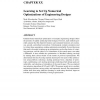850 search results - page 91 / 170 » Using Machine Learning to Guide Architecture Simulation |
ICML
2008
IEEE
14 years 9 months ago
2008
IEEE
Deep Belief Networks (DBN's) are generative models that contain many layers of hidden variables. Efficient greedy algorithms for learning and approximate inference have allow...
CORR
2004
Springer
13 years 8 months ago
2004
Springer
An approach to robotics called layered evolution and merging features from the subsumption architecture into evolutionary robotics is presented, and its advantages are discussed. T...
AAAI
1994
13 years 9 months ago
1994
New approaches to solving constraint satisfaction problems using iterative improvement techniques have been found to be successful on certain, very large problems such as the mill...
AIEDAM
1998
13 years 7 months ago
1998
Gradient-based numerical optimization of complex engineering designs offers the promise of rapidly producing better designs. However, such methods generally assume that the object...
WCAE
2006
ACM
14 years 2 months ago
2006
ACM
Learning the various structures and levels of memory hierarchy by means of conventional procedures is a complex subject. A memory hierarchy environment (Web-MHE) was proposed and ...


